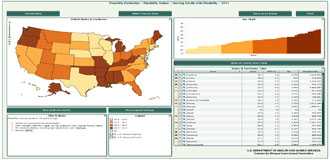New Features added to Disability and Health Data System (DHDS)
There are 1 in 5 adults in the U.S. living with a disability. To reduce health disparities, state-based data are needed to provide support for programs and services that can effectively improve the health of people with disabilities.
There are 1 in 5 adults in the U.S. living with a disability. Disability is often equated with poor health; however, people with disabilities can and should have the same opportunity for good health as people without disabilities. Compared to people without disabilities, people with disabilities are more likely to be obese, smoke and have more difficulty accessing preventive health services. To reduce these health disparities, state-based data are needed to provide support for programs and services that can effectively improve the health of people with disabilities.
Disability and Health Data System (DHDS) is an innovative disability and health data tool that provides instant access to state-level, disability-specific health data. DHDS is intended to raise awareness of health disparities experienced by adults with disabilities in order to inform program and policy initiatives aimed at improving the health of people with disabilities.
New features of the data tool include:
- 2011 Behavioral Risk Factor Surveillance System (BRFSS) data. 2011 BRFSS data were analyzed and added to DHDS and are populated in maps, data tables, and state profiles.
- New single year indicators stratified by demographics groups. All 2011 health indicator data are available among adults with disabilities and adults without disabilities overall, and by age, sex, and race/ethnicity.
- New p-values for each disparity estimate. 2011 data include p-values for each health disparity; these are available in data tables and State Profiles.
- Improved indicator names. The indicator names were revised to make it easier to interpret the information being viewed.
Why should organization use DHDS?
DHDS can be used to help support the development of data-driven, fiscally-responsible programs, services, and policies that include people with disabilities.
DHDS data tool:
- Provides state-level data to support programs and efficiently allocate resources to improve the health of adults with disabilities.
- Identifies differences in health for adults with disabilities compared with adults without disabilities.
- Generates research questions to investigate factors that contribute to differences in health experienced by adults with disabilities.
- Identifies opportunities to include adults with disabilities in programs and policies.
By using DHDS, public health programs can:
- Determine the percentage of adults with disabilities in a state.
- Compare state health data for adults with disabilities to adults without disabilities.
- View data on a range of health topics for a single state.
- Create and download customizable data tables.
Visit DHDS at http://dhds.cdc.gov to see the most recent data on the health of adults with disabilities in your health program area or your state.
Questions? Please email dhds@cdc.gov.
For more information on Disability and Health, visit https://www.cdc.gov/ncbddd/disabilityandhealth
- Page last reviewed: April 15, 2014
- Page last updated: April 15, 2014
- Content source:


 ShareCompartir
ShareCompartir
